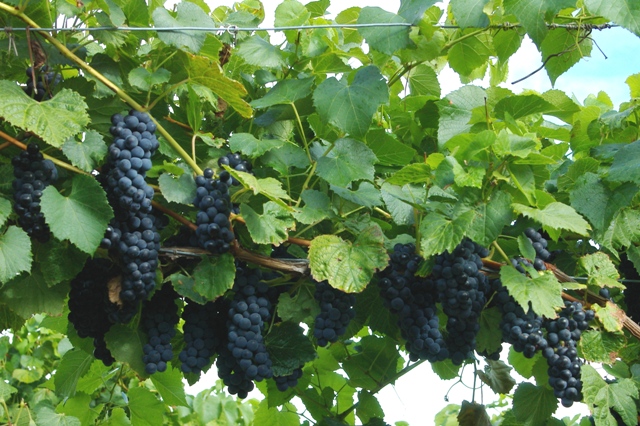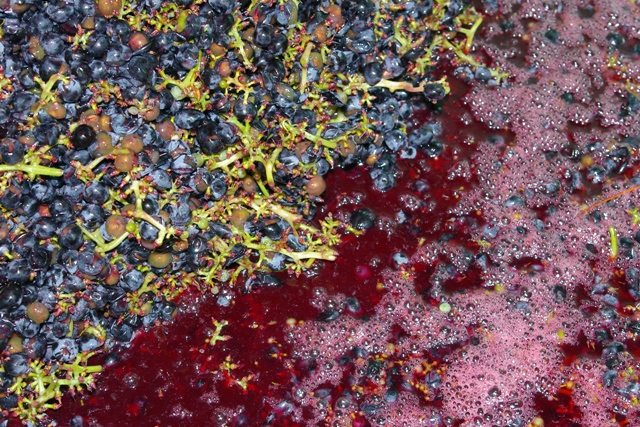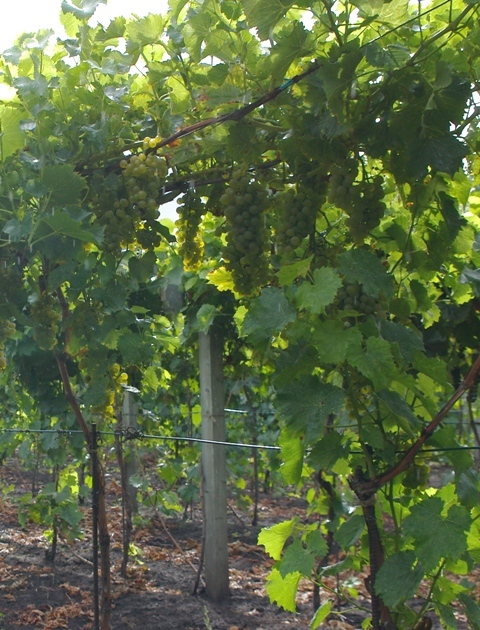Grape Growing in Manitoba and on the Prairies

It is possible to grow grapes in Manitoba and on the prairies using varieties breed for Northern climates. Many of the newer hardy varieties have a number of good characteristics for fresh eating and wine making. Many of the hardy varieties were developed at the University of Minnesota wine grape research program. Their winemaker researchers evaluate hundreds of wines produced from experimental grape varieties each year in order to identify hybrids with superior wine quality potential and to develop styles of wine unique to Minnesota. The program also supports the rapidly expanding grape and wine industry in Minnesota through teaching and extension activities.
There are many considerations when growing grapes:
- Intended use (table, juice, wine, ornamental)
- Ripening season length in your region
- Variety Selection (disease resistance, product desired, climate)
- Winter Protection (system used)
Consideration of the conditions in your area must be foremost before going large scale however as you still need land suitable for grape production. As well, more effort and inputs will be needed for grapes used for winemaking/ fresh eating compared to simple ornamental uses.
Ornamental Grapes
Grapes have good vigour to cover trellis rapidly with thick foliage, perfect for adding some green to a home landscape. Grapes many laterals can easily and quickly spread over a fence, wall trellis, pergola, etc. The fruit from ornamental type grape varieties is more for show not yield and taste. As a result the fruit from these varieties may not be suitable for eating or winemaking.

Suitable Ornamental Use Variety
Valiant
- Hardy to -35°C, rarely injured
- Old reliable, also grown for solely ornamental reasons, very aggressive growth
- Mid-season ripening
- Also good for jams
Dessert/Table (fresh eating)/Jam Grapes
The varieties that are consideration suitable for jams, desserts or as table grapes must be sweet tasting, generally earlier ripening and productive. These varieties usually have grapes with good colour (as opposed to green types), relatively thick-skinned and easy to pick.
Suitable Dessert/Table (fresh eating)/Jam Varieties
Bluebell-1944
- Withstands -35°C
- Early ripening
- Seeded table grape
- Concord-like flavour
- Thick skinned
- Light red juice, also good for jam
Edelweiss-1978
- One of the earliest ripening hardy varieties
- Good for table, juice, and jam
- Wine with mild “classic labrusca” flavour
- May require some winter protection to ensure reliable fruiting
Swenson Red-1978
- Midseason, red grape
- Tender skinned
- Good table grape
- Downy Mildew a problem
- Will require winter protection
Other Varieties Worthy of Consideration: Interlaken, Concord, Himrod
Wine Grapes
Effort increases with wine grapes as they need to be trained to ensure good light and ripening conditions. Training helps keep the vines productive with consistent crop load every year.

Suitable Wine Use Varieties- “Recent” Cold-Hardy Grape Varieties
Frontenac -1996
- Withstands -38°C, without serious injury
- Ripens late Mid-season, same as Frontenac
- White wine and deemed excellent-very fruity flavour
Marquette-2005
- Withstands -35°C, without serious injury
- Ripens Mid-season, earlier than Frontenac
- Good resistance to Powdery and Downy Mildew
- Red wine quality deemed excellent
Frontenac Gris-2003
- Withstands -38°C, without serious injury
- Ripens late Mid-season, same as Frontenac
- White wine and deemed excellent-very fruity flavour
La Crescent-2002
- Withstands -35°C, without serious injury
- Ripens late-season, but may still work in Manitoba
- Yield moderate
- White wine reminiscent of Riesling, good dessert wine
Troubadour
- Withstands -40°C, without serious injury
- Ripens early season
- Small berries, not good commercially
- Very vigourous
- Deep Red Juice, good additive to dessert wines
St. Croix
- Main red wine variety in Quebec (-29°C)
- Ripens mid- season
- Juice a pale rose in colour
- Can survive down to -33°C
- Needs snow cover to overwinter
- Not very productive
Sabrevois
- Comparable to St. Croix but hardier (-35°C)
- Ripens mid- season
- Has performed well in Quebec
- Survives most Minnesota winters
- Very vigourous
- Very dark wines, often better blended
Other Varieties Worthy of Consideration-Super Hardy (-40°C)
D.M. 8521-5, E.S. 10-18-30
Other Varieties Worthy of Consideration- Hardy to -35°C
Kay Gray, E.S. 5-4-16, St. Pepin, Louise Swenson, Swenson White, Prairie Star
Determining Growth and Ripening Potential in Your Region
Another consideration when thinking of operating a commercial vineyard are total frost free days as many varieties require long development periods to ripen. Even if a variety is winter hardy, damaging frosts in the spring or fall can end any fruit production.

Ripening Considerations
- Ultra-early varieties: 600-800 GDD and 110-135 frost free days
- Early varieties:800-1000 GDD and 135-150 days to mature
- Mid-Season varieties: 1000-1250 GDD
- Late Season varieties: 1250-2250 GDD (must be harvested before ripening)
- Vinifera whites varieties -1000-1250 GDD, Vinifera reds 1150-1500 GDD, with a 180 day growing season (not happening in here)
Estimating Spring Frost Susceptibility
- Determine 10°C day (when average temperature of max and min=10°C)
- Estimate bud swell date (usually about 24 to 29 GDD)
- Date of last killing frost (e.g. Portage, MB= May 14 to May 19th; Brandon, MB =May 24th to 29th)
- If date of last killing frost comes before budswell, then you are fine
- If it comes after budswell, look for later ripening varieties.
Hardiness Ranges for Grapes Varieties that Have Potential in Manitoba
- Tender -18°C to -23°C
- Slightly -21°C to -26°C
- Moderately Hardy -23°C to -29°C
- Hardy -26°C to -32°C
- Very Hardy -32°C to -37°C
- Super Hardy Below -37°C
Winter Protection
It is often necessary to provide additional protection to grapes during the winter months. Many Grapes are usually covered in some way to minimize heat loss and keep temperature above ambient. Various materials can be used to protect the grape crown and roots: soil and mulch, cornstalks, straw, cedar chips, shredded newspaper, construction foam board could be used.
Vines can be laid on the ground (droppable trellis system) and also covered by geotextile (protective fabric).
In spring if frost risk still exists after growth has started, try placing clear plastic over the vine as heat is retained (plastic encloses new vine growth and protects from frost).
Pathogens capable of damaging grapevines are present in Manitoba
At present level of concern is low: Diseases to look for: Downy Mildew, Powdery Mildew, Anthracnose, Eutypa Dieback/Dead Arm
At present level of concern is low: Diseases to look for: Downy Mildew, Powdery Mildew, Anthracnose, Eutypa Dieback/Dead Arm

